对爱琴海浅层岩礁上大型藻类群落的评价表明,该地区的生态状况很差
IF 2.3
3区 环境科学与生态学
Q1 MARINE & FRESHWATER BIOLOGY
引用次数: 3
摘要
由于人为压力和气候变化的增加,地中海岩礁正经历着结构复杂和多样化的状态,从以树冠形成的大型藻类为主的结构复杂和多样化状态转变为以低洼草皮或覆盖大型藻类物种为特征的退化状态。利用从整个爱琴海89个地点收集的数据,本研究旨在基于大型藻类群落结构,对该地区的浅层岩石礁进行最全面的健康状况评估。总共在0、5和15 m深度通过光样方采样收集了2520张底栖生物图像。群落结构描述考虑了5个大藻和7个无脊椎动物的形态功能群,以及4个底物类别。采用reef-EBQI和EEI-c指数评价健康状况。结果表明,草皮是分布最广的大型藻群(平均面积覆盖36.8%),其次是包壳钙质(16.6%)、灌木状(12.7%)、铰接钙质(8.9%)和冠层形成藻(3.7%)。裸露的岩石也占据了相当大的表面积(9.0%),在5米处覆盖面积最高(13.8%)。形成冠层的藻类覆盖面积特别低,平均在0 m深度为10% ~ 15 m深度为0.1%。根据珊瑚礁- ebqi指数,综合所有深度,爱琴海的生态状况估计为“坏”,主要是由于5和15 m站的生态状况较差。在0米深度,根据珊瑚礁- ebqi指数,爱琴海的状态被评为“中等”,根据EEI-c指数,爱琴海的状态被评为“良好”。这些结果强调了在评估岩石珊瑚礁群落健康状况时考虑广泛深度范围的重要性。本文章由计算机程序翻译,如有差异,请以英文原文为准。
Assessment of macroalgal communities on shallow rocky reefs in the Aegean Sea indicates an impoverished ecological status
Mediterranean rocky reefs are undergoing regime shifts, from a structurally complex and diverse state dominated by canopy- forming macroalgae to a degraded one characterised by low-lying turf or encrusting macroalgal species, due to increased anthropogenic pressure and climate change. Using data gathered from 89 sites across the entire Aegean Sea, this study aims to provide the most comprehensive health status assessment of shallow rocky reefs in the area, based on macroalgal community structure. Overall, 2520 benthic images were collected through photoquadrat sampling at 0, 5 and, 15 m depth. Five macroalgal and seven invertebrate morphofunctional groups, along with four substrate categories, were considered for community structure description. Health status was assessed using the reef-EBQI and EEI-c indices. Results indicate turf as the most widespread macroalgal group (36.8% average area cover), followed by encrusting calcareous (16.6%), shrubby (12.7%), articulated calcareous (8.9%), and canopy-forming algae (3.7%). Bare rock also occupied a substantial surface area (9.0%) with highest cover (13.8%) at 5 m. The area cover of canopy-forming algae was particularly low, ranging from 10% at 0 m to 0.1% at 15 m depth, on average. All depths pooled, according to the reef-EBQI index, the ecological status of the Aegean Sea was estimated to be ‘Bad’, mainly due to the bad ecological status of the 5 and 15 m stations. At 0 m depth, the status of the Aegean Sea was ranked ‘Moderate’ according to the reef-EBQI index and ‘Good’ according to the EEI-c index. The results underline the importance of considering a wide depth range when assessing the health status of rocky reef communities.
求助全文
通过发布文献求助,成功后即可免费获取论文全文。
去求助
来源期刊

Mediterranean Marine Science
MARINE & FRESHWATER BIOLOGY-
CiteScore
5.20
自引率
17.90%
发文量
34
审稿时长
>12 weeks
期刊介绍:
The journal Mediterranean Marine Science (MMS), published by the Hellenic Centre for Marine Research (HCMR), issues three volumes annually. The journal welcomes original research articles, short communications, New Mediterranean Biodiversity records, extended reviews, comments, and Theme sections in all fields of Oceanography, Marine Biology, Marine Conservation, Fisheries and Aquaculture in the Mediterranean area and the adjacent regions. All content is peer reviewed.
 求助内容:
求助内容: 应助结果提醒方式:
应助结果提醒方式:


